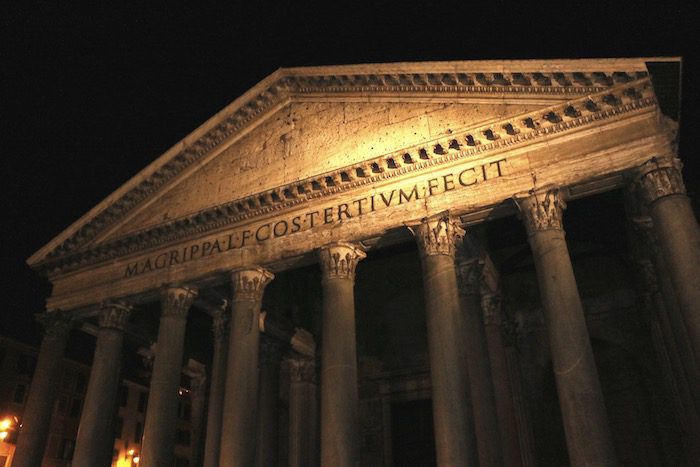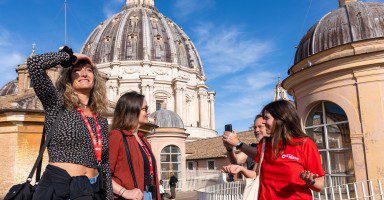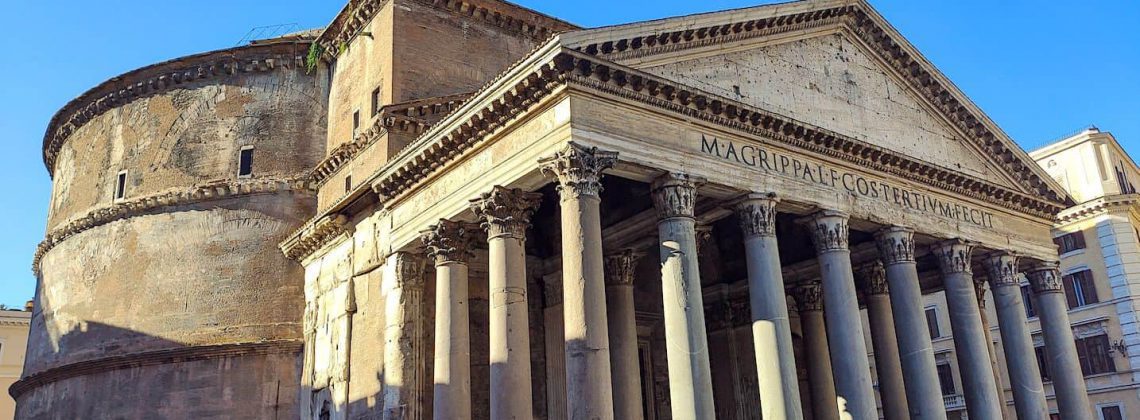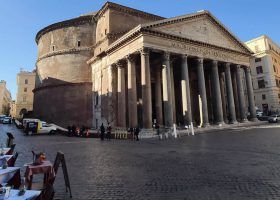The Pantheon is not only one of the Ancient wonders of the world but is synonymous with Rome today. This massive temple/ church/ monument has been fascinating us for the last two thousand years. But how much do you really know about the Pantheon and how about some cool Pantheon facts?
Pro Tip: It’s easier to organize your trip when you have all your resources in one place. Create a browser folder and bookmark this post. Also, check out our guide to Rome for more planning resources, our top Rome tours for a memorable trip, and the top things to do near the Pantheon.
Astounding Facts about the Pantheon
While there were many temples built throughout the Roman empire, none of them have been continually in service for the last 2,000 years. The Pantheon has stood the test of time and become a national monument in Rome. It’s a must for every first-time visitor to Rome.
In fact, many locals visit the Pantheon regularly to take in the perfection of this architectural wonder. But how much do you really know about this structure? Keep reading for astounding Pantheon facts ahead of your next visit. Want to see the Pantheon with an expert guide? Join us on our popular skip-the-line Pantheon guided tour.
Not ready to book a tour? See if Rome tours are worth it.
17. The Pantheon’s Original Purpose Is Unknown

One of the strangest facts about the Pantheon is that we don’t know who built it. The word “pantheon” translates to all-worship or all-gods depending on how you look at it. Contrary to what many have written on the internet, the use of the building was not to worship all pagan gods.
Pagan gods didn’t appreciate sharing a temple with other gods. Some exceptions are for gods conjoined in their purposes like Castor and Pollux. Also, a deified couple like Antonius Pius and Faustina his wife share a temple. But in general, the Romans built temples dedicated to a single deity.
What the Romans used the Pantheon for is undocumented at best, making any reason I provide mostly assumption or guesswork. A strong theory from the Professor of Archeology, Amanda Claridge, is that the Pantheon existed for the worship of emperors yet to be deified.
It is no mystery that Romans didn’t like to worship emperors as gods until after their death. Claridge states in her Rome Archeological Guide, “the Pantheon provided a setting–not a temple in the conventional sense–in which the living emperor would appear in the company of the gods (including his own deified predecessors).
16. This Is the Third Pantheon Structure on this Site
According to Amanda Claridge, the Pantheon was first built between 27-25 B.C. but that building would not be recognizable today. The first structure was built by Marcus Agrippa who was a Roman Consul under the first Emperor of Rome, Ceaser Augustus. The original structure was built primarily out of wood and subsequently burnt down about 100 years later in A.D. 80.
Domitian took a second shot at it, but the structure was struck by lightning and burnt to the ground in A.D. 110. At the time, these incidents would have come across as very bad omens for Rome during an otherwise prosperous time. Lightening was controlled by Jupiter (Zeus) and if it struck the building it would likely signify he was unhappy with it or Romans in general.
Trajan, emperor at the time, likely began the third structure and Hadrian would have finished it. Hadrian was a great emperor and very humble, so he did not dedicate the structure to himself—something he only did one time. Instead, he dedicated it to the man who originally built it: Marcus Agrippa.
Popular Rome Tours

Best Seller
Privileged Entrance Vatican Tour with Sistine Chapel
This our most popular and longest-running Vatican tour to date. You’ll enter the Vatican Museums an hour before the public opening and see the breathtaking Sistine Chapel. Admissions are included and our English-speaking guides do a wonderful job bringing the museums to life!
See Prices

Customer Favorite
Rome in a Day Tour with Vatican, Sistine Chapel, Colosseum, and More!
Looking to get much of your sightseeing done in one day? This tour enters the Vatican an hour before opening and visits the Colosseum along with other sites like the Pantheon, Piazza Navona, and Trevi Fountain. All admissions and transportation are included as well as a licensed, English-speaking guide!
See Prices
Not ready to book a tour? Check out our best Rome tours to take and why.
15. We Are Uncertain Who Built the Pantheon

Who built the Pantheon? Many believe the architect responsible is Apollodorus of Damascus but this is speculation. We do know that Hadrian commissioned renovations on the Pantheon, which were completed between A.D. 125 and A.D. 128.
14. The Pantheon Became a Church
One of the most astounding facts about the Pantheon is its survival. In A.D. 609, the Pantheon was converted into a church by Pope Boniface IV. A rough history states that Christians complained about being plagued by pagan ghosts haunting the building, so it was converted to a church.
This is the principal reason that the building is still standing today. Many other ancient Roman buildings were built to withstand time, but not the recycling of their building material. Once it was a church, nobody was allowed to loot it. It’s still a church to this day and is called St. Mary and the Martyrs.
13. There Are Kings Buried Inside the Pantheon

Vittorio Emanuele was a Sardinian King who successfully unified all of the sub-kingdoms of Italy to form one great nation between 1861 and 1871. He was from the Casa Savoia, which was a great noble family established in A.D. 1003. Their family still has successors today although their titles are not recognized.
Emmanuel’s army, led by the great Giuseppe Garibaldi, successfully unified the peninsula under the rule of one monarch. Some sub-kingdoms joined peacefully and others by force. The final stop was the battle of Castelfidardo, which is when Garibaldi fought and was victorious over the papal forces. The idea of the Catholic church controlling armies is extremely foreign to us today.
Victor Emmanuel II died in 1878 and was buried in the Pantheon. His tomb reads Padre della Patria, which translates to the “Father of the Fatherland.” The fact that he was allowed to be buried here is a mystery.
Pope Pius IX refused to meet with Emmanuel after he overtook Rome and never acknowledged his reign. Then, he allowed him to be buried inside the Pantheon, a Catholic Church. Umberto I, the second and last King of Italy and also a Savoia, is buried in the same tomb.
12. The Pantheon Porch Should Be Higher
The porch is significantly different from the inner drum. It is quite literally the square peg and round hole dilemma. Many speculate as to why the building’s porch design does not match the width of the drum.
If you look directly at the structure, you can see the drum behind the porch which, for a lack of better words, makes the exterior look ugly. Some think this was due to a shortage of materials during construction or even a shipwreck that caused the loss of some columns from Egypt.
11. Famous Painter Raphael Is Buried In the Pantheon

Raphael’s tomb is on the back left-hand side of the structure. He’s buried next to his fiancée Maria Bibbiena, which was not by his design. He was madly in love with Margherita Lute—a baker’s daughter and the subject of many of his works of art including La Fornarina (Palazzo Barberini), which translates literally to the baker’s daughter.
Raphael, who lived from 1483 to 1520 and may have died on his birthday, is located under a statue of Mary holding baby Jesus to her left, which was done by an artist named Lorenzetto.
His tomb reads ILLE HIC EST RAFFAEL, TIMUIT QUO SOSPITE VINCI, RERUM MAGNA PARENS ET MORIENTE MORI. Translated by Alexander Pope, it reads, “Living, great nature feared he might outvie Her works; and, dying, fears herself may die.”
Top-Rated Rome Tours
Not ready to book a tour? Find out if Rome tours are worth it.
10. The Original Inscription Is Still there

While Hadrian commissioned the rebuilding of the temple for the third time, the original inscription to Marcus Agrippa is still there. Hadrian tended not to put his own name on the structures he rebuilt. Marcus Agrippa was the top general of Augustus, the first emperor of Rome.
The inscription on the front reads: M AGRIPPA L. F. COS TERTIUM FECIT or “Marcus Agrippa, Son of Lucius, Thrice Consul, Made This.” There’s also another inscription that is extremely difficult to say that reads: pantheum vetustate corruptum cum omni cultu restituerunt or “with every refinement they restored the Pantheum, worn by age.” This was likely a superficial upgrade that would be non-structural.
There are two massive statues of Caesar Augustus and Marcus Agrippa on the front porch in the two alcoves. There are also statues of Venus and Mars. Julius Caesar, the father of Augustus, claimed to have descended from Venus.
9. The Walls of the Pantheon Are Really, Really Thick
One of the coolest facts about the Pantheon is its massive walls. As you can imagine, you must have a pretty solid foundation to build something as big as the Pantheon that has lasted as long as it has.
They also had to build the walls 20 feet (6 meters) thick in order to take the pressure of the dome. This is because, when you build a dome, pressure is exerted outwards and not just down.
While today it’s hard to see, there are certain areas inside where you can get a peek. When you compare the original brick to other parts of the interior, it gives you a great idea of how thick the walls actually are.
8. The Bronze Was recycled

In the 17th century, Pope Urban VIII (Barberini) ordered significant material to be taken from the Pantheon, including the bronze adorning the ceiling of the portico. This is where the phrase, “What the barbarians did not do the Barberini did” comes from.
This refers to the barbarians who sacked Rome in antiquity taking most of its wealth. The bronze was used for Bernini’s famous Baldacchino in St. Peter’s Basilica.
7. There Were Once Bell Towers
One of the overlooked facts about the Pantheon is that there were once bell towers. In an attempt to make the building resemble a church, the Barberini pope ordered Bernini to create two bell towers.
These were put up around the same time that the bronze was removed in order to decorate other buildings throughout the city. Later, in the 19th century, they were removed as they were nicknamed the ass’s ears.
6. The Pantheon Doors Are Not Original

The current bronze doors that you see at the Pantheon are ancient, but they are not the originals. You can tell that the door is too small by looking at the marble door frame. Together with the threshold, they have been deeply recut to accommodate the smaller doors.
That’s not to say that they haven’t been there for a long time. They’ve been there since at least the 15th century. Supposedly, the original doors of the Pantheon could be those of the church of St. John of Lateran, but we’ll never truly know!
5. The Columns are One Solid Piece of Stone
Each of the columns is one piece of stone. In ancient times, it was quite common to build columns using many slabs of marble or stone piled up in such a way as to make it almost unnoticeable that they were not one piece. Each of these columns is one solid piece of stone and they are 48 feet (15 meters) high!
Since the columns would have come from Egypt, how in the world did they get them to Rome? Well, first they would have to transport them by ship across the raging Mediterranean Sea, which could take months.
Once they got them to land, they’d have to drag them on wooden rollers (yes, drag 48-foot columns by hand) until they arrived at their desired spot. At that point, they would usually raise them up with elephants. Impressed yet?
Popular Vatican Tours

Best Selling Tour
Privileged Entrance Vatican Tour with Sistine Chapel
Without the right access, visiting the Vatican means fighting crowds, long waits, and missing the most significant rooms and works of art. Our privileged entrance tour offers more than just entry—it’s an immersive experience led by a storytelling guide who brings the Vatican to life. Skip the line and explore the Vatican Museums, including the Raphael Rooms, the Sistine Chapel, and St. Peter’s Basilica with engaging insights that make each moment memorable and meaningful.
See Prices

Top Rated Tour
Ultimate St. Peter’s Basilica Dome Climb and Tour with Papal Tombs
Visiting St. Peter’s Basilica and its dome on your own can mean dealing with crowds and waiting in line for hours. Our early-morning tour, led by a captivating local guide, ensures you skip the hassle with privileged access and insider knowledge, including the best times to climb for awe-inspiring views. Explore the stunning Basilica, take in breathtaking panoramas, and descend into the sacred Papal Crypts for a truly immersive experience.
See Prices
Not ready to book a tour? Check out our best Vatican tours to take and why.
4. Originally the Area wasn’t So Open

Today, any buildings right next to the Pantheon have been removed, which makes it much more prominent. Back in the day, there were definitely a few differences.
First of all, the ground was much lower, so you would have needed to walk up a large row of steps to get inside the Pantheon. Today, you actually walk down into it due to the higher ground level.
Secondly, there was a covered portico over the entire area on all three sides leading up to the building. This portico would have had colonnades in marble going all the way around it.
Connected to the back of the Pantheon was a temple dedicated to Neptune. Today, if you go behind the monument, you can still see some friezes in marble of dolphins.
3. There’s a Hole in the Pantheon Dome

Once you walk inside, your eyes will be drawn to the dome above you. Many people stop in the doorway causing traffic jams and we can’t blame them. That’s exactly the effect the architect would have longed for.
The architecture of Rome was heavily focused on showing the superiority of the Romans, and the Pantheon was no different. The opening in the center is called an oculus in Latin, which means “eye.” Rain and other elements do get inside the structure when the doors are closed.
You’ll see the floor slopes down into the center and drains in place to allow water to leave the structure. There’s a bronze ring on the interior of the oculus and there would likely have been decorative bronze fixtures in all of the 140 coffers. By having an opening in the middle like that, it would have allowed for natural light to enter and brighten the entire temple.
2. The Dome Is Awesome!
These could be facts or opinions about the Pantheon, but I think the dome is simply awesome! The building is 145 feet (44.4 meters) tall by 145 feet (44.4 meters) wide and built completely from stone, brick, and concrete.
The dome is made entirely out of concrete with five rows of 28 coffers that decrease in size as you get closer to the oculus. Archeologists have studied the building extensively and realized that they used lighter and lighter materials in the cement the higher up they got. This allowed the building to sustain all the pressure on it. Genius!
The dome is a perfect hemisphere and you would be able to fit a sphere inside the structure with a diameter of 44.4 meters, which would touch the ceiling, floor, and walls. The building is perfect and thus its construction is a mystery.
Some believe a complex scaffolding was used to lay the concrete, while others believe the entire building was filled with sand from Ostia. Today, all you can do is admire it.
1. The Dome Is Record-Breaking!

Remember that the Pantheon was built 2,000 years ago. Keep that in mind as I tell you that it held the record for the largest span of concrete until 1958! The CNIT building in Paris finally beat it.
Want another record? Well, the Pantheon is also the largest unreinforced concrete dome ever built—even to this day! If this doesn’t impress you my friends, then nothing will.
Not ready to book a tour? See if Rome tours are worth it.

Where To Stay in Rome
Rome has a rich cultural history and many iconic landmarks to explore. Plan where to stay in the magnificent Eternal City in the best neighborhoods.






the pantheon is soooooooo cool!!!!!!!!!!! i cant believe kings were buried there! and raphael the painter was buried there too!!!!! i cant believe it!!!! he seemed pretty interresting not to mention you can see his tomb!!!!!!!! i wish we knew the builder
Thank you — well done! Very interesting and just enough information to walk away feeling a little more knowledgeable about this ancient building.